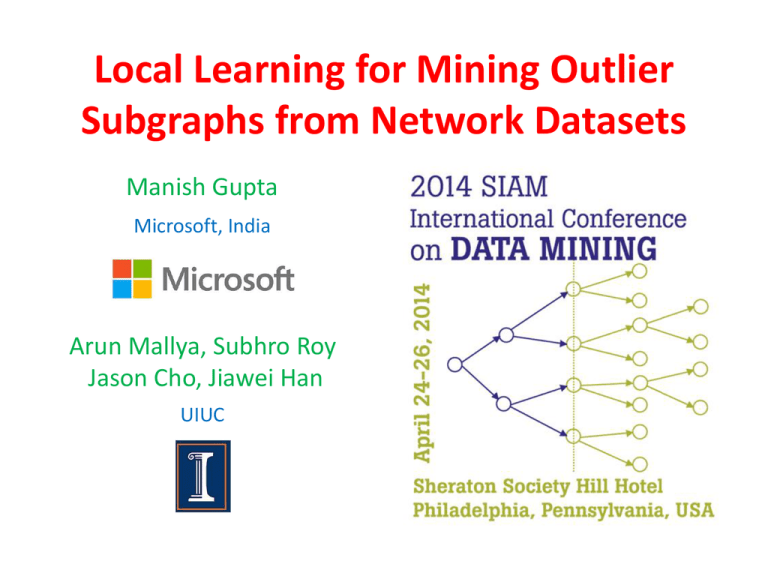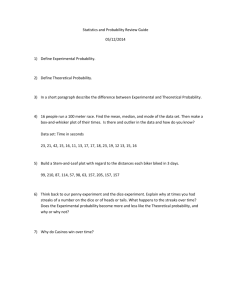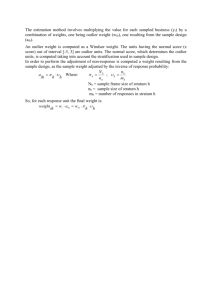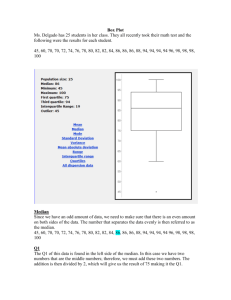TopK Interesting Subgraph Discovery in Information Networks
advertisement

Local Learning for Mining Outlier Subgraphs from Network Datasets Manish Gupta Microsoft, India Arun Mallya, Subhro Roy Jason Cho, Jiawei Han UIUC Motivation (1) • Query based subgraph outlier detection – A security officer may like to find some tiny but suspicious activity clubs from a massive social network, such as Facebook – Network security companies might be interested in discovering a group of computers running malicious software as botnets – Based on the intelligence obtained so far, an analyst would like to gather information about a terrorist ring with particular features. • How does one define the outlierness of a subgraph? gmanish@microsoft.com 2 Motivation (2) • Subgraph instantiations of a user query, can be marked as outliers with respect to their connectivity structure within and in the neighborhood of subgraph Data Mining Author Theory Author User query: 3-author clique Normal Anomalous gmanish@microsoft.com Anomalous 3 Contributions • Propose the problem of finding subgraph outliers that adhere to an input subgraph template query • Present a max-margin framework to compute outlierness score of a subgraph match • Compare local, partition-wide and global strategies to learn outlier score • Show interesting results on both synthetic and real datasets gmanish@microsoft.com 4 Relationship with Previous Work • Previous work has studied – Outlier detection of single nodes from a network [GLF+10], [GGSH12a], [GGSH12b] • We perform subgraph outlier detection – Context used to define an outlier is usually the entire network or a latent community • We allow the user to define the context using a subgraph type query – Finding matching subgraphs for a given subgraph query [ZH10] • We discover ranked matching subgraphs gmanish@microsoft.com 5 Solution Overview • For a subgraph consider the dataset of linked node pairs and non-linked node pairs over all nodes in the subgraph and its neighborhood • A max-margin hyperplane can be learned such that it best separates the linked node pairs from non-linked ones • The features could be the dissimilarity scores between the attribute values of the nodes in the node pair • Negative margin of the max-margin hyperplane can be used as an outlier score gmanish@microsoft.com 6 The System Subgraph Query Top K Outlier Score Outlier Score Outlier Score Outlier Score Outlier Score gmanish@microsoft.com Outlier Score 7 Definitions (1) • Entity relationship graph 𝐺 = ⟨𝑉, 𝐸, 𝐴⟩ – Each node has an attribute vector with dimensionality 𝐷 and values in [0,1] • Subgraph query 𝑄 with 𝑉𝑄 > 1 • Matches: Instantiations of the query template 𝑄 in 𝐺 • Dis-similarity for a node pair 𝑇 – DisSim(u,v)=𝑤𝑀 |𝐴 𝑣 − 𝐴(𝑢)| • Max-margin Hyperplane for a match 𝑀 – Hyperplane that best separates linked node pairs from non-linked ones in the space of dissimilarity of attribute values, such that the node pairs are obtained from the neighborhood of 𝑀 gmanish@microsoft.com 8 Definitions (2) • Margin – 𝐿𝑀 be the minimum dis-similarity for any non-linked node pair in match 𝑀 – 𝐻𝑀 be the maximum dis-similarity for any linked node pair in match 𝑀 – 𝐿𝑀 − 𝐻𝑀 is the margin • Outlier score for match 𝑀 is 𝐻𝑀 − 𝐿𝑀 • Subgraph Outlier Detection Problem – Given: An entity-relationship graph 𝐺, a query 𝑄 – Find: Top few matching subgraphs with highest outlierness scores gmanish@microsoft.com 9 Computation of Subgraph Matches • Construct offline SPath index • When a subgraph query comes in – Run the query 𝑄 on network 𝐺 using the index and growing the matches in a path-at-a-time fashion – Get all matches 𝐹 – Compute corresponding induced match 𝑀 for each 𝐹 • An induced match 𝑀 is the subgraph of the graph 𝐺 induced by the nodes in 𝐹 • Next compute outlier score for each 𝑀 gmanish@microsoft.com 10 Estimating the Weight Vector (1) • Outlier score needs estimation of the feature weight vector 𝑤 and the margin • Max-margin hyperplane should ideally be able to separate the linked node pairs from the non-linked ones • Such a hyperplane should achieve maximum possible margin – Max 𝐿𝑀 − 𝐻𝑀 gmanish@microsoft.com 11 Estimating the Weight Vector (2) • For all edges in the neighborhood of match 𝑀, dissimilarity should be upper-bounded by 𝐻𝑀 𝑇 – 𝑤𝑀 𝐴 𝑢 −𝐴 𝑣 ≤ 𝐻𝑀 𝑇 – 𝑤𝑀 𝐴 𝑢 −𝐴 𝑣 ≥ 𝐿𝑀 – 0 ≤ 𝑤𝑀 𝑖 ≤ 1 ∀𝑖 = 1 … 𝐷 • For every node pair (𝑢, 𝑣) in the neighborhood of match M not linked by an edge, dis-similarity should be lower-bounded by 𝐿𝑀 • Elements of the weight vector need to be bounded and constrained – 𝐷 𝑖=1 𝑤𝑀 𝑖 =1 gmanish@microsoft.com 12 Estimating the Weight Vector (3) • Adding the slack variables to account for the non-separable case, LP can be written as follows • max 𝐿𝑀 − 𝐻𝑀 − |𝑆 𝐶 𝐿 ∪𝑆𝑁𝐿 | |𝑆𝐿 ∪𝑆𝑁𝐿 | 𝜉𝑖 𝑖=1 subject to the following constraints – For each edge (𝑢, 𝑣) in the neighborhood of match 𝑀 • 𝑇 𝑤𝑀 𝐴 𝑢 −𝐴 𝑣 • 𝜉𝑢,𝑣 ≥ 0 ≤ 𝐻𝑀 + 𝜉𝑢,𝑣 – For each non-linked node pair (𝑢, 𝑣) in the neighborhood of match 𝑀 • • 𝑇 𝑤𝑀 𝐴 𝑢 −𝐴 𝑣 𝜉𝑢,𝑣 ≥ 0 – 0 ≤ 𝑤𝑀 𝑖 ≤ 1 – • • • 𝐷 𝑖=1 𝑤𝑀 ≥ 𝐿𝑀 − 𝜉𝑢,𝑣 ∀𝑖 = 1 … 𝐷 𝑖 =1 𝑆𝐿 : set of linked node pairs in neighborhood of match 𝑀 𝑆𝑁𝐿 : set of non-linked node pairs in neighborhood of match 𝑀 𝜉𝑖 : slack variable linked with the node pair 𝑖 gmanish@microsoft.com 13 Subgraph Outlier Detection Algorithm (SODA) • Input: (1) Graph 𝐺, (2) Query 𝑄, (3) Parameter 𝛿 • Output: Top subgraph outliers – Compute set of all matches for query 𝑄 on graph 𝐺 using 𝑆𝑃𝑎𝑡ℎ(𝐺, 𝑄) – for each match 𝑀 do • Compute 𝑤𝑀 using the LP • Compute the outlier score 𝑂𝑆(𝑀) – Compute mean 𝜇 and variance 𝜎 2 for outlier scores for all matches – Find subgraph outliers as subgraphs with outlier score > 𝜇 + 𝛿𝜎 • Computational complexity – Let B be average number of neighbors for any node – – – – LP has 𝑂 2(𝐵 𝑉𝑄 )2 + 𝐷 + 1 constraints and 𝑂 (𝐵 𝑉𝑄 )2 +𝐷 + 2 variables Interior point methods are linear in the number of variables In practice, simplex takes time linear in number of constraints Matches can be processed in parallel gmanish@microsoft.com 14 Experiments (Baselines) • Global Weight Vector (GlobalW) – Randomly choose a set of matches – Sample a few nodes from all these matches – Design a LP by considering all linked and non-linked node pairs from this sample – Compute a global w and use it to compute 𝐿𝑀 and 𝐻𝑀 for each match 𝑀 • Partition-wide Global Weight Vector (PartitionW) – Partition the graph using METIS [KK98] – For each partition 𝑝 • Compute margin for a random match within 𝑝 • Repeat the above step until the margin is sufficiently high • Compute partition-wide w and use it to compute 𝐿𝑀 and 𝐻𝑀 for each match 𝑀 • Uniform Weight Vector (UniformW) – Each 𝑤𝑖 is fixed to 1/𝐷 gmanish@microsoft.com 15 Synthetic Dataset Results N 1000 2000 5000 Ψ(%) 1 2 5 1 2 5 1 2 5 SODA 85.7 83 81.7 85 90.2 91.2 90 79.3 92.2 |D| = 4 PW GW 12.4 91.1 22.5 82.3 23.6 75.4 14 78 24.5 77.1 36.6 84.7 21.2 84.7 40.3 82.7 53.3 83.7 UW 67 71.4 76.8 80.1 79.5 84.7 87.7 70.5 86.3 SODA 86.2 89.7 92.1 93.4 87.9 93.6 85.6 90.3 93.7 |D| = 6 PW GW 11.1 77.2 15.2 75.4 29.7 79.3 13.3 76.1 31.6 79 40.4 80.1 19.3 76.4 24.3 81 32.7 82.7 UW 76.9 73.1 84.6 79.8 80.5 86 75.3 80 84.2 SODA 81.4 77 77.3 87.9 92.9 96 89.2 91.5 95 |D| = 10 PW GW 19.5 80.3 27.8 79.2 31.7 82.8 21.5 67.6 29.7 74.3 45.7 78 28.8 69.4 38.1 73.9 52.2 77.4 UW 66.2 65.5 68.9 69.5 77.1 82.9 77.7 79.7 86.9 • Experimented with wide variety of experimental settings • Dataset was generated by first generating the network such that nodes with low dissimilarity values are connected by an edge • Query-based outliers were injected by setting attribute vectors of selected nodes to random values • SODA has better accuracy than PartitionW which is better than GlobalW • Average accuracy of the four methods • SODA: 88.1%, PartitionW: 78.9%, GlobalW: 28.2%, and UniformW: 77.7% gmanish@microsoft.com 16 Real Datasets Nodes Edges Attributes Number of Nodes, Edges and Attributes in each Dataset Four Area DBLP Yeast Network 27199 30599 3112 66832 146647 12519 4 14 183 Number of Subgraph Template Matches in each Dataset Four Area DBLP Yeast Network 3-Clique 86390 153336 6590 4-Clique 130389 112851 3134 5-Clique 272900 352389 1937 5-Subgraph 4082687 9472728 264593 3-Clique 4-Clique 5-Clique 5-Subgraph Execution Time for SODA (in seconds) Four Area DBLP 89 385 140 265 269 796 4524 23314 gmanish@microsoft.com Yeast Network 76 35 22 3045 17 Real Datasets Outlier Score 0.5 3-Clique 0.4 4-Clique 0.3 5-Clique 0.2 5-Subgraph 0.1 1 8 15 22 29 36 43 50 57 64 71 78 85 92 99 0 Percent Matches Outlier Score Variation for the Four Area Dataset for four Different Queries Yeast Protein Interaction Network gmanish@microsoft.com 18 Case Studies (1) • 3-Clique Query on Four Area Dataset • Top outlier is (Sepandar D. Piotr Indyk Aristides Gionis Kamvar, Taher H. Haveliwala, Gene H. Golub) Taher H. Haveliwala • These authors and their Gene H. Golub neighborhood mainly consists of IR and ML authors Dan Klein • The outlierness comes in Christopher D. because of a few links with Manning some database authors (Hector Sepandar D. Kamvar Garcia-Molina, Piotr Indyk) and also a data mining author (Aristides Gionis) Mario T. Schlosser Hector Garcia-Molina • Inter-disciplinary collaborations cause outlierness gmanish@microsoft.com 19 Case Studies (2) • 4-Clique Query on Yeast Network 1 • Top outlier is (ydl147w, ydr394w, ydr427w, yfr010w) • These four proteins and other interacting proteins contain a large percentage of the following dipeptides: LK, LL, EL, LS, LE, SL, SS, AL, EE, KL, LA, EK, DL, KE, VL, IL, AA, LI, DE, IS. • A few proteins (like ydr201w, yhr027c, yfr052w, ynl250w, ydl147w, ymr308c, ylr106c) contain very small amounts of these dipeptides. • Instead their sequences contain high percentages of other dipeptides like IE, LD, KK, KS, LN, NL, AS, DA, EN, LQ. gmanish@microsoft.com 20 Related Work • Outlier Detection for Static Networks – – – – Minimum Description Length (MDL) [NC03, Cha04] Egonets [AMF10, HERF+10] Random walks [SQCF05, MT06] Random field models [QAH12, GLF+10] • Outlier Detection for Temporal Networks – Graph Similarity based Outlier Detection Algorithms [DK03, PDGM10, Pin05] – Evolutionary Community Outlier Detection Algorithms [GGSH12a, GGSH12b] – Online Graph Outlier Detection Algorithms [AZY11, IK04] gmanish@microsoft.com 21 Conclusions • Proposed the problem of identifying subgraph outliers that adhere to an input subgraph query template based on deviations in linkage compared to the neighborhood • Discussed a methodology to compute the outlierness of a subgraph match based on a max-margin framework • Using several synthetic datasets, we observed that a local method outperforms a partition-wide approach which in turn is more accurate than a global strategy in extracting the injected outliers across a wide variety of experimental settings • Showed interesting and meaningful outliers detected from the Four Area and DBLP co-authorship graphs, and the Yeast protein interaction graph gmanish@microsoft.com 22 Acknowledgments • The work was supported in part by the U.S. Army Research Laboratory under Cooperative Agreement No. W911NF-11-2-0086 (CyberSecurity) and W911NF-09-2-0053 (NSCTA), the U.S. Army Research Office under Cooperative Agreement No. W911NF-13-1-0193, and U.S. National Science Foundation grants CNS0931975, IIS-1017362, and IIS-1320617. • We would also like to thank the Institute for Genomic Biology at University of Illinois, Urbana Champaign for their equipment. gmanish@microsoft.com 23 Thanks! gmanish@microsoft.com 24 References (1) • • • • • • • • • • • • [AMF10] Leman Akoglu, Mary McGlohon, and Christos Faloutsos. Oddball: Spotting anomalies in weighted graphs. In Proc. of the 14th Pacific-Asia Conf. on Advances in Knowledge Discovery and Data Mining (PAKDD), pages 410–421. Springer, 2010. [AZY11] Charu C. Aggarwal, Yuchen Zhao, and Philip S. Yu. Outlier Detection in Graph Streams. In Proc. of the 27th Intl. Conf. on Data Engineering (ICDE), pages 399–409, 2011. [CCCX11] K. Chakrabarti, S. Chaudhuri, T. Cheng, and D. Xin. EntityTagger: Automatically Tagging Entities with Descriptive Phrases. In Proc. of the 20th Intl. World Wide Web Conf. (WWW), pages 19–20, 2011. [CFSV04] Luigi P. Cordella, Pasquale Foggia, Carlo Sansone, and Mario Vento. A (Sub)Graph Isomorphism Algorithm for Matching Large Graphs. IEEE Transactions on Pattern Analysis and Machine Intelligence (TPAMI), 26(10):1367–1372, 2004. [Cha04] Deepayan Chakrabarti. AutoPart: Parameter-free Graph Partitioning and Outlier Detection. In Proc. of the 8th European Conf. on Principles and Practice of Knowledge Discovery in Databases (PKDD), pages 112–124, 2004. [CYD+08] Jiefeng Cheng, Jeffrey Xu Yu, Bolin Ding, Philip S. Yu, and Haixun Wang. Fast Graph Pattern Matching. In Proc. of the 24th Intl. Conf. on Data Engineering (ICDE), pages 913–922, 2008. [DDGM12] Abir De, Maunendra Sankar Desarkar, Niloy Ganguly, and Pabitra Mitra. Local Learning of Item Dissimilarity using Content and Link Structure. In Proc. of the 6th ACM Conf. on Recommender Systems (RecSys), pages 221–224, 2012. [DK03] P. Dickinson and M. Kraetzl. Novel Approaches in Modelling Dynamics of Networked Surveillance Environment. In Proc. of the 6th Intl. Conf. of Information Fusion, volume 1, pages 302–309, 2003. [FSNW13] Yaping Feng, Judith A. Syrkin-Nikolau, and Eve S. Wurtele. Creating Subnetworks from Transcriptomic Data on Central Nervous System Diseases informed by a Massive Transcriptomic Network. Interdisciplinary Bio Central (IBC), 5(1):1–8, Jan 2013. [GGSH12a] Manish Gupta, Jing Gao, Yizhou Sun, and Jiawei Han. Community Trend Outlier Detection using Soft Temporal Pattern Mining. In Proc. of the European Conference on Machine Learning and Knowledge Discovery in Databases (ECML PKDD), pages 692– 708, 2012. [GGSH12b] Manish Gupta, Jing Gao, Yizhou Sun, and Jiawei Han. Integrating Community Matching and Outlier Detection for Mining Evolutionary Community Outliers. In Proc. of the 18th ACM SIGKDD Intl. Conf. on Knowledge Discovery and Data Mining (KDD), pages 859–867, 2012. [GLF+10] Jing Gao, Feng Liang, Wei Fan, Chi Wang, Yizhou Sun, and Jiawei Han. On Community Outliers and their Efficient Detection in Information Networks. In Proc. of the 16th ACM SIGKDD Intl. Conf. on Knowledge Discovery and Data Mining (KDD), pages 813–822, 2010. gmanish@microsoft.com 25 References (2) • • • • • • • • • • • • [HERF+10] Keith Henderson, Tina Eliassi-Rad, Christos Faloutsos, Leman Akoglu, Lei Li, Koji Maruhashi, B. Aditya Prakash, and Hanghang Tong. Metric Forensics: A Multi-level Approach for Mining Volatile Graphs. In Proc. of the 16th ACM SIGKDD Intl. Conf. on Knowledge Discovery and Data Mining (KDD), pages 163–172, 2010. [HS08] Huahai He and Ambuj K. Singh. Graphs-at-a-time: Query Language and Access Methods for Graph Databases. In Proc. of the 2008 ACM SIGMOD Intl. Conf. on Management of Data (SIGMOD), pages 405–418, 2008. [IK04] Tsuyoshi Id´e and Hisashi Kashima. Eigenspace-based Anomaly Detection in Computer Systems. In Proc. of the 10th ACM Intl. Conf. on Knowledge Discovery and Data Mining (KDD), pages 440–449, 2004. [KK98] George Karypis and Vipin Kumar. A Fast and High Quality Multilevel Scheme for Partitioning Irregular Graphs. SIAM Journal on Scientific Computing, 20(1):359–392, Dec 1998. [KSB+09] Martin I Krzywinski, Jacqueline E Schein, Inanc Birol, Joseph Connors, Randy Gascoyne, Doug Horsman, Steven J Jones, and Marco A Marra. Circos: An Information Aesthetic for Comparative Genomics. Genome Research, 2009. [KT09] R. Kumar and A. Tomkins. A Characterization of Online Search Behavior. IEEE Data(base) Engineering Bulletin, 32(2):3–11, 2009. [LZ11] L. L¨u and T. Zhou. Link prediction in complex networks: A survey. Physica A Statistical Mechanics and its Applications, 390:1150–1170, Mar 2011. [McK81] Brendan D. McKay. Practical Graph Isomorphism. Congressus Numerantium, 30:45–87, 1981. [MT06] H. D. K. Moonesignhe and Pang-Ning Tan. Outlier Detection Using Random Walks. In Proc. of the 18th IEEE Intl. Conf. on Tools with Artificial Intelligence (ICTAI), pages 532–539, 2006. [NC03] Caleb C. Noble and Diane J. Cook. Graph-Based Anomaly Detection. In Proc. of the 9th ACM SIGKDD Intl. Conf. on Knowledge Discovery and Data Mining (SIGKDD), pages 631–636. ACM, 2003. [PDGM10] Panagiotis Papadimitriou, Ali Dasdan, and Hector Garcia-Molina. Web Graph Similarity for Anomaly Detection. Journal of Internet Services and Applications, 1(1):19–30, 2010. [Pin05] Brandon Pincombe. Anomaly Detection in Time Series of Graphs using ARMA Processes. ASOR Bulletin, 24(4):2–10, 2005. gmanish@microsoft.com 26 References (3) • • • • • • • • • • • • • [QAH12] Guo-Jun Qi, Charu C. Aggarwal, and Thomas S. Huang. On Clustering Heterogeneous Social Media Objects with Outlier Links. In Proc. of the 5th ACM Intl. Conf. on Web Search and Data Mining (WSDM), pages 553–562, 2012. [SQCF05] Jimeng Sun, Huiming Qu, Deepayan Chakrabarti, and Christos Faloutsos. Neighborhood Formation and Anomaly Detection in Bipartite Graphs. In Proc. of the 5th IEEE Intl. Conf. on Data Mining (ICDM), pages 418–425, 2005. [SWW+12] Zhao Sun, Hongzhi Wang, Haixun Wang, Bin Shao, and Jianzhong Li. Efficient Subgraph Matching on Billion Node Graphs. Proc. of the VLDB Endowment (PVLDB), 5(9):788–799, May 2012. [TMS+07] Yuanyuan Tian, Richard C. Mceachin, Carlos Santos, David J. States, and Jignesh M. Patel. SAGA: A Subgraph Matching Tool for Biological Graphs. Bioinformatics, 23(2):232–239, Jan 2007. [Ull76] J. R. Ullmann. An Algorithm for Subgraph Isomorphism. Journal of the ACM, 23(1):31–42, Jan 1976. [WSP07] Chao Wang, Venu Satuluri, and Srinivasan Parthasarathy. Local Probabilistic Models for Link Prediction. In Proc. of the 7th IEEE Intl. Conf. on Data Mining (ICDM), pages 322–331, 2007. [ZCL07] Lei Zou, Lei Chen, and Yansheng Lu. Top-K Subgraph Matching Query in a Large Graph. In Proc. of the ACM 1st Ph.D. Workshop in CIKM (PIKM), pages 139–146, 2007. [ZCO09] Lei Zou, Lei Chen, and M. Tamer ¨Ozsu. Distance-join: Pattern Match Query in a Large Graph Database. Proc. of the VLDB Endowment (PVLDB), 2(1):886–897, Aug 2009. [ZCYF12] Xianggang Zeng, Jiefeng Cheng, Jeffrey Xu Yu, and Shengzhong Feng. Top-K Graph Pattern Matching: A Twig Query Approach. In The 13th Intl. Conf. on Web-Age Information Management (WAIM), pages 284–295, 2012. [ZH10] Peixiang Zhao and Jiawei Han. On Graph Query Optimization in Large Networks. Proc. of the Very Large Databases (PVLDB), 3(1):340–351, 2010. [ZHY07] Shijie Zhang, Meng Hu, and Jiong Yang. Treepi: A novel graph indexing method. In Proc. of the 23rd Intl. Conf. on Data Engineering (ICDE), pages 966–975, 2007. [ZLY09] Shijie Zhang, Shirong Li, and Jiong Yang. GADDI: Distance Index Based Subgraph Matching in Biological Networks. In Proc. of the 12th Intl. Conf. on Extending Database Technology: Advances in Database Technology (EDBT), pages 192–203, 2009. [ZYJ10] Shijie Zhang, Jiong Yang, and Wei Jin. Sapper: Subgraph indexing and approximate matching in large graphs. Proc. of the VLDB Endowment (PVLDB), 3(1):1185–1194, 2010. gmanish@microsoft.com 27





![[#GEOD-114] Triaxus univariate spatial outlier detection](http://s3.studylib.net/store/data/007657280_2-99dcc0097f6cacf303cbcdee7f6efdd2-300x300.png)
